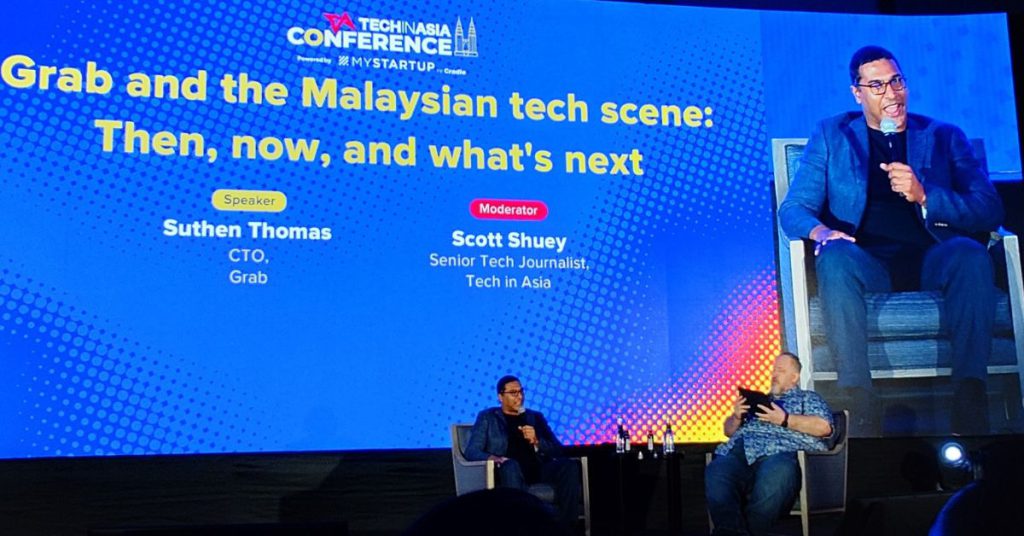Building “boring” solutions is key for tech startups, says Grab’s CTO. Here’s why.
Grab’s CTO, Suthen Thomas Paradatheth, shares practical strategies for building successful tech startups in Malaysia.

Building a tech startup is often romanticised as a journey filled with innovation and disruption.
However, according to Grab’s Chief Technology Officer (CTO), Suthen Thomas Paradatheth, the key to success might just be the opposite: building boring solutions.
During Tech in Asia Conference 2024, Suthen shared insights into the company’s early days and the philosophy that guided its growth.
Surprisingly, it wasn’t about chasing the latest tech trends or building complex systems. Instead, it was about identifying simple, practical solutions to everyday problems.
“Find interesting and challenging customer problems to solve, but solve it with the most boring technical solution possible,” he said.
“It’s counterintuitive, but using the latest buzzword-compliant technology doesn’t always add value to the customer.”
Focus on the problem, not the technology
Grab’s journey began with the simple idea of making taxi rides more convenient and affordable for passengers while ensuring drivers earn a decent living.
To tackle this, he said the company introduced a credit system that allowed drivers to earn money upfront and a bidding system that matched passengers with the nearest available driver.
These solutions might seem basic now, but they were revolutionary at the time. More importantly, they were achieved without relying on cutting-edge technology.
“None of these had anything to do with the technology stack we used,” Suthen explained. “It was about solving the problem, not showing off our tech skills.”
Malaysia as a breeding ground for innovation
Malaysia has emerged as a surprising hotbed for tech startups. The country’s young, tech-savvy population, coupled with a strong focus on education, creates a fertile ground for startups.
“Malaysia has a highly competent, well-educated workforce, especially in STEM,” the CTO said. “It’s a great jump-off point to solve problems for the rest of Southeast Asia.”
 Image Credit: Vulcan Post
Image Credit: Vulcan PostGrab itself is an example of this potential. Starting as a small team in Malaysia, the company has grown into a regional giant. As of last year, it has over 100,000 ride-hailing drivers in Malaysia alone.
The role of artificial intelligence
While artificial intelligence (AI) has undeniably transformed industries, it’s essential to approach it with a clear-headed perspective.
Suthen cautioned against the temptation to prioritise AI for AI’s sake. Instead, the focus should remain on how AI can be used to solve real-world problems and improve the customer experience.
“We need to be careful with AI, to not fall in love with the technology without considering what customer problems we’re trying to solve,” he said.
Grab’s journey with AI exemplifies this approach. The company has successfully integrated AI into various aspects of its operations, from predicting arrival times to enhancing safety features.
However, the focus remains the same, to use technology as a tool to deliver better results for users, not as a standalone achievement.
“Machine learning allowed us to have scalable but effective solutions that get further up on optimisation,” the CTO explained. “It’s about finding the most boring way to solve a complex problem.”
In a world obsessed with the latest tech trends, Grab’s story might be a refreshing reminder that sometimes, the most effective solutions are the simplest ones.
By focusing on the customer and building boring but reliable products, the company has managed to disrupt an entire industry.
Learn more about Tech in Asia Conference 2024 here. Read other articles we’ve written about Malaysian startups here.Featured Image Credit: Grab

 Aliver
Aliver 






















![Is ChatGPT Catching Google on Search Activity? [Infographic]](https://imgproxy.divecdn.com/RMnjJQs1A7VQFmqv9plBlcUp_5Xhm4P_hzsniPsfHiU/g:ce/rs:fit:770:435/Z3M6Ly9kaXZlc2l0ZS1zdG9yYWdlL2RpdmVpbWFnZS9kYWlseV9zZWFyY2hlc19pbmZvZ3JhcGhpYzIucG5n.webp)








